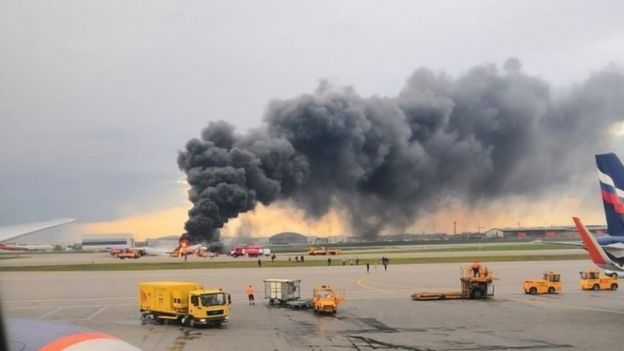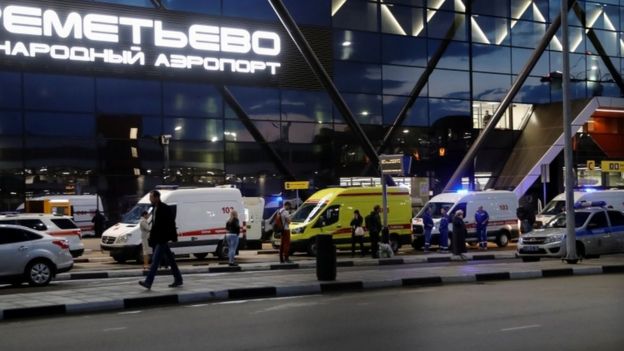Moscow plane crash lands killing 41
Forty-one people died after a Russian plane made an emergency landing and burst into flames just after takeoff from Moscow’s Sheremetyevo airport.
Dramatic video shows passengers using emergency exit slides to escape the burning Aeroflot aircraft.
Survivors suggest the plane was struck by lightning, but Russia’s national carrier said only that it returned to the airport for technical reasons.
Two children are among the dead. The jet had 73 passengers and five crew.
Initial reports suggested the plane had landed on fire, but sources quoted by Russian news agency Interfax said the jet caught fire after a very bumpy landing.
The aircraft landed with full fuel tanks because the crew lost contact with air traffic controllers and decided it was too dangerous to dump fuel over Moscow, Interfax added.
“There are 37 survivors – 33 passengers and four members of the crew,” said Yelena Markovskaya, an official involved in the investigation of the crash.
A flight attendant was also reportedly killed in the incident. Five people are in hospital. One witness said it was a “miracle” anyone escaped.

Russian Prime Minister Dmitry Medvedev has ordered a special committee to investigate the disaster.
What happened to the plane?
The aircraft, a Sukhoi Superjet-100, left the airport at 18:02 local time (15:02 GMT), bound for Murmansk.
Its crew sent a distress signal when “malfunctions” occurred in bad weather shortly after take-off.
After making an emergency landing at the airport, the plane’s engines caught fire on the runway, Aeroflot said, adding that the crew “did everything to save the passengers”.

One passenger who survived the crash, Petr Egorov, was quoted by the Komsomolskaya Pravda daily newspaper as saying that the flight “had just taken off and the aircraft was hit by lightning”, adding: “The landing was rough – I almost passed out from fear.”
Aeroflot published a list of survivors (in Russian) who have been identified so far.
Murmansk’s Acting Governor Andrey Chibis has reportedly said that the families of those killed in the fire will each receive one million rubles ($15,300; £11,630), while the victims being treated in hospital will be given 500,000 rubles ($7,650; £5,815).

How did the survivors escape?
Mikhail Savchenko claims he was on the plane when it exploded into a fireball on the tarmac but “managed to jump out”.
He shared a video of passengers running away from the burning plane, posting: “‘Guys I am all right, I am alive and in one piece.”
One of the surviving passengers, Dmitry Khlebushkin, said that he was very grateful to the flight attendants. “Only thanks to the flight attendants, I survived,” he told reporters.
Kristian Kostov, a former Bulgarian Eurovision contestant, has posted on social media about witnessing the incident.
He said people at the airport were left “shaking” after seeing the aircraft engulfed by fire.
Another eyewitness, Patrick Horlacher, told the BBC it was “shocking to see” the plane being ravaged by flames just minutes before he was due to board another flight.
Russian President Vladimir Putin has reportedly been briefed and expressed condolences to the families of victims.
The region of Murmansk has announced a three-day mourning period.
Can lightning bring down a plane?
With millions of commercial flights taking place every year, lightning strikes in the air are relatively common.
Traditional planes, built using aluminium, are usually able to withstand such strikes as the shell or “skin” of the aircraft acts as a cage, distributing the electricity without causing damage and allowing them to continue their journey safely.
Some newer aircraft are constructed using lighter materials that have lower electrical conductivity, such as carbon fibre, which need to be protected – often using wire mesh or foil.
In addition, the electronics and connections to an aircraft’s fuel tanks are heavily shielded to protect them from external electrical bursts.
Lightning strikes can cause technical malfunctions, causing planes to divert or make emergency landings for precautionary reasons. But crashes following such incidents are rare.
A strike is still likely to be noticed by people on board, though. Passengers may hear loud bangs or experience the cabin lighting up with a bright flash.



